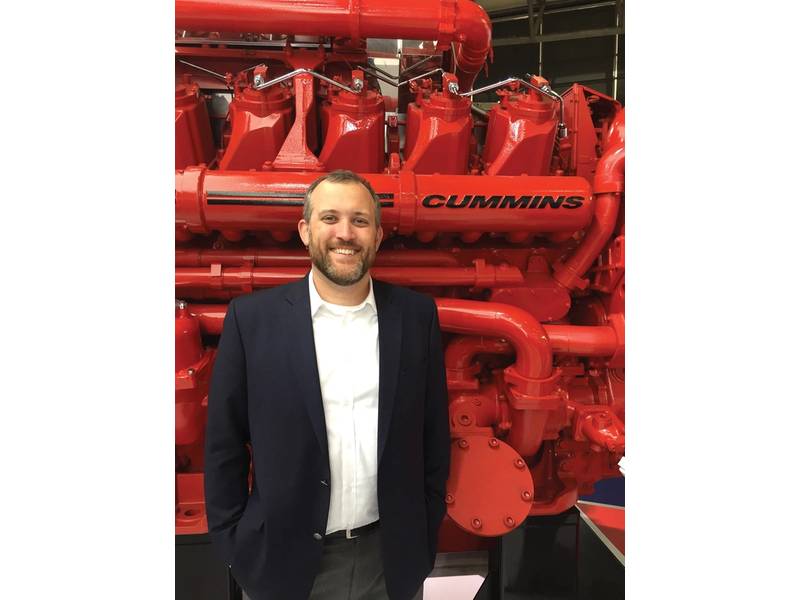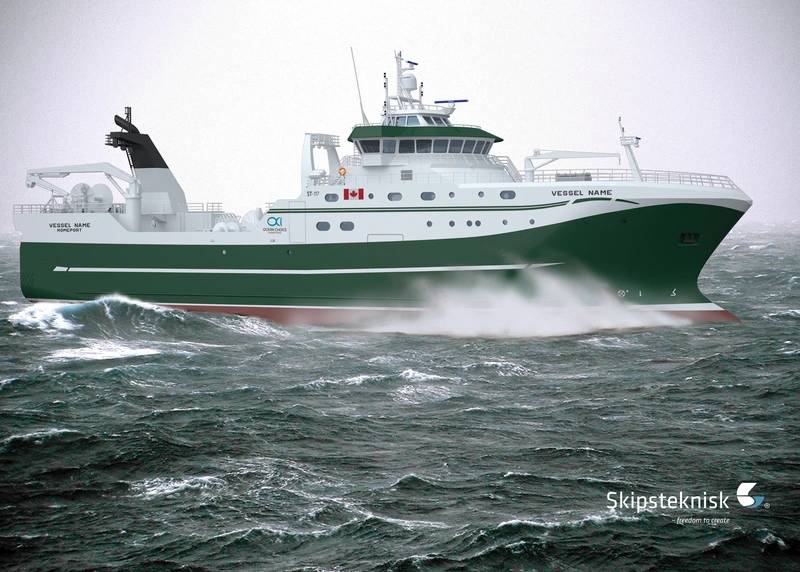Interview: Edmonds Brown, Cummins, Inc.
The May 2019 edition of Maritime Reporter & Engineering News features a eight-page feature section on "Thought Leadership" in the marine power sector. Here we extract and present the interview with Edmonds Brown, Cummins, Inc., Commercial Marine Segment Leader.
Please put in perspective and discuss the current environment and pressure to reduce emissions in the maritime industry.
When I started in the marine industry, my primary focus was working to achieve certification of Cummins’ marine engines for U.S. Environmental Protection Agency (EPA) Tier 1 and International Marine Organization (IMO) Tier I standards. Back then, there was a single solution to meet all the regulations. This was not only easier on engine manufacturers, it was easier on the fleet owners, too, providing them with only one system to implement and maintain.
Since then, not only have emissions regulations gotten more stringent, but they are also increasingly siloed, making it difficult to scale research and development across platforms. On the surface, today’s emissions regulations appear to have similarities. But in reality, they are very different. At the same time, the landscape is continuing to diverge, with more regulations, such as China stage 1 and 2, taking effect. Each regulation is distinct and challenging, which, from a solutions perspective, means each requires a lot of work.

This presents a business challenge as well. It could be difficult to make the business case to offer options to meet every regulation on every engine. Since the regulations are different, it’s difficult to scale a single project to comply with every standard, every time. We have also seen the cycle between regulations decreasing, meaning that once you meet current regulations, you already need to focus on developing solutions to meet the next standards.
This isn’t unique to engine manufacturers. Fleet owners and operators also feel the challenge. As regulations change, ship designs must also be adapted. This means the fleet isn’t standardized and it’s difficult to consider lessons on emissions from previous generations of vessels.
At Cummins, our development often builds on existing platforms. This enables us to build on existing solutions, which helps our customers standardize their fleets as much as possible.
How does this pressure compare to the other industries you serve? What technologies or ‘lessons learned’ from other industries are you applying to maritime solutions? Please be specific.
Cummins is much more than a marine business. Our company is a diversified business that participates in many market segments. This allows us to leverage significant investments across numerous segments and platforms and benefit from knowledge and experience gained over thousands of product launches
All markets that Cummins serves have emissions regulations. Being involved in so many diverse segments on a global scale is a strength when looking at how we can adapt solutions for use in the maritime industry. For example, Cummins has been involved in meeting complex on-highway emissions for more than 20 years. Our early adaptation of aftertreatment solutions for the on-highway market, whose strict emissions regulations are ahead of most, has carried over to our marine solutions.
In addition, our Cummins Emission Solutions business delivers products not just for Cummins’ engines, but for engines built by other companies, too. The technology they develop really distinguishes us. Even some of our competitors use these products in different segments.

Emissions control, across our business, is an area where Cummins is investing time, energy, and money. Given the diverse standards we must meet – not just in marine, but in all of our segments around the world – we are making significant investments to meet evolving regulations.
Four to five unique regulations drive work on our marine engine platforms alone. When you look at how many engine platforms Cummins has across all its business segments, and multiply that by the unique emissions regulations that we need to meet, you begin to see how expansive and all-encompassing meeting emissions regulations can be.
At Cummins our strategy is to develop diversified and dependable power solutions. One of the ways the company is doing that is through electrification. Cummins plans to be a leader in electrified power and we believe this business segment will provide the innovation and focus to ensure future success.
We started work on electric powertrains long before the Electrified Power business started last year and we have been working with electrification for decades in areas such as hybrid engines. Cummins is focusing initially on full electrification in the urban bus and truck markets because that’s where we think the infrastructure for electrification will develop first.
But you can see the results of the company’s work with hybrid engines in the marine market. Examples include Enhydra, a large excursion boat, which was named Professional Mariner’s 2019 Boat of the Year, and Skipsteknisk’s new stern trawler, an IMO III vessel which uses electricity to power the ship’s fish factory, freezing machinery and quarters for the ship’s crew.
FUEL: There is justifiably vibrant discussion surrounding fuel choice. Do you see one fuel emerging today as the ‘next big thing?’
Diesel continues to be the most viable fuel right now and probably in the foreseeable future for our marine customers. While there are ongoing discussions around alternative fuel sources, such as natural gas, LNG, methane, and electric, there is no one standout among them. For the industry to switch, mariners will want to see that a new fuel is a viable and dependable option, and that the global infrastructure exists to support it.
If diesel prices were to increase, it could possibly open the market to wider adaptation alternatives such as LNG. But it would require a massive updating in infrastructure within the shipping industry for alternatives to be used on a wide scale. The good news is that the low-quality diesel fuel that has been used by the marine industry for decades is now being blended with cleaner, higher quality fuel to help meet tougher emissions standards around the world.
There can be significant variations in blending. With ships bunkering in different regions of the world, blends are not necessarily compatible and quality can be inconsistent. That’s where our Fleetguard fuel filters and other technologies can play an important role in helping out customers meet regulations.
The combination of improved fuels and the innovation we discussed earlier in exhaust aftertreatment has made a huge difference in the on-highway market and I think it can make a difference in marine, too. That means we can still make a positive impact on the environment today while determining if any alternative fuel source will get us where we want to go tomorrow.
Put in perspective ‘Autonomous Marine Operations’. Is it a real conversation with your clients today, or a topic far in the future? How is your organization preparing for the advent of autonomy in the maritime space?
The traditional definition of an autonomous vessel piloting itself across the ocean means very little to the engine. But when you look at the broader need for less human interaction for maintenance, diagnostics and repairs, this is where Cummins has been working with customers to adapt, develop, and implement technology.
Imagine an engine that requires less human touch. An engine controlled remotely, running longer between service intervals, performing standard maintenance on itself and diagnosing its own problems. Cummins is already deploying this kind of technology across various platforms.
I think there are pockets where autonomous marine operations make sense today, but as far as widespread adoption in the marine industry goes, there are still many factors to consider.
At Cummins, we believe tough but fair regulations can be a key factor in driving innovation. Regulations can create clear goals and a level playing field for companies to innovate. But the regulations must be enforced. If enforcement is inconsistent, the only loser is the one who complies.
Our Government Relations team meets with policy makers around the world talking about how economic development and competitiveness can flourish when regulations are clear and enforceable. Unfortunately, as I said earlier, they vary widely in the marine industry from country to country and region to region, ranging from strict standards to almost no requirements.
Our customers must consider what regulations they will need to meet when they build a new vessel and that can lead to variations within their fleets and our supply chain that complicate a whole host of issues including maintenance and product lifecycles.
Fortunately, as the potential impacts of emissions on our environment becomes increasingly clear, more and more countries are embracing tougher standards. In areas other than marine, we’re seeing more consistency and that bodes well for innovation and the future. But even more consistency would make it easier for companies in our industry to innovate.
The IMO last year dropped the gauntlet to reduce maritime emissions 50% by 2050. Is that target achievable, and if so, which fuels or technologies will be key to success? Same Question as above, but comment on the prospects of zero carbon emissions?
Our culture of innovation at Cummins and the company’s focus on sustainability makes me optimistic about the future. We have made some incredible strides in emissions aftertreatment across many different markets using many different platforms. Cummins is working on its own environmental sustainability plan right now tied to 2050 that will be announced later this year. So, it’s a topic getting a lot of attention at every level of our company.
In addition, technical innovation is happening faster now than maybe at any time in our company’s 100-year history. So, it’s hard to predict what technology we’ll use or the fuels that will get us where we want to go.
Cummins wants to bring to customers a broad portfolio of solutions to their power needs, including clean diesel, natural gas, electrified power or, in the future, some fuel source maybe we don’t even know about right now. The bottom line is that we want our customers to be able to choose the power solution that’s best for them.
As for zero carbon emissions, that’s a terrific goal but a very challenging one, as well. I know at Cummins, our approach will be to look for ways we can have the biggest impact possible on building a better world today, then accomplish them and then look for new ways we can make a difference.
Please discuss a recent product (or service) introduction(s) that you see as transformational for owner/operators of commercial ships and boats.
ENHYDRA: Earlier we mentioned Enhydra, the large excursion boat now based in San Francisco. Some are calling the 600-seat vessel one of the “greenest” boats in America
It has a lithium-ion battery-electric hybrid propulsion system that can complete extended cruises completely on electricity. Each of the vessel’s two screws are connected to generators powered by 410-horsepower Cummins QSL9 diesel engines.
QSK95: In March of 2018, Cummins announced that Azam Marine had selected two QSK95 engines to power its next passenger ferry, the Kilimanjaro VII, which will operate between the islands of Zanzibar, Pemba and mainland Tanzania. The QSK95 is the largest engine diesel engine Cummins makes. The high-speed diesel engine offers a power output previously exclusive to much larger medium-speed marine engines with power ratings from 3,200 to 4,200 horsepower for propulsion, auxiliary, generator and diesel electric applications. The QSK95 has a lower capital cost, more compact installation and exceptional fuel efficiency when compared to other engines in its class, which translates into lower greenhouse gases.
THE X15: Also in 2018, Cummins announced that a version of its extremely popular X15 engine was available for commercial marine markets including inland waterways, commercial fishing and passenger transport. The engine has more power and durability than any other high-speed marine engine. The marine X15 is designed to withstand high hour, continuous duty operation, offering variable speed and fixed speed ratings between 450 horsepower (336 kW) and 600 horsepower (447 kW), while meeting EPA Tier 3 and IMO Tier II emission standards.
